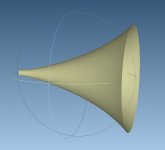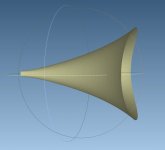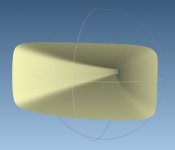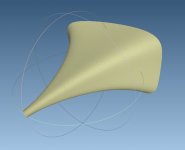You hardly see any true horns in modern commercial PA products for reasons of directivity
As in CD vs non CD??
Rob 🙂
Because they lie. They take advantage of the fact that for non pa, loading isn't usually a factor. Loading "should" be a length of 1/2WL or better, but you'll see products going 1/4th and smaller.
How do you define "loading"? I look at it from the usable lower limit in a frequency response measurement.
Rob 🙂
Watching this animation immediately made me think of when someone was describing how it sounded on a horn that was crossed too low, as if the sound was coming from some where inside the throat. If you look at this animation you can see the sound pressure front initiate inside the throat and eventually make its way out.
The Jericho 45 does not have this issue at 200hz. Me so happy.
I think you do a complete misinterpretation here. These are no sound waves coming out the horn. The video is simply sequentially animating the observation fields for each frequency. So, you only get an animated impression of this metric
The horn is essentially an air coupler between the environment and the diaphragm. This coupling presents a mass load of air between the two, which translates as acoustical impedance. During this spectrum of frequency the driver is more efficient and the diaphragm has to move much less in order create spl. When a cd/horn combo reaches a frequency where this relationship no longer exist, it is now said to have unloaded or, basically, loading is not taking place. Acoustically, impedance has dropped significantly, the diaphragm must move a much greater distance to achieve spl and the pressure front is basically right in front of the diaphragm instead of in front of the horn. During loading, in a nutshell, the wave front is at or nearing the diameter of the horns opening upon exit, while unloaded, the wave front is the size of diaphragm. So like listening to 200hz from a 4” woofer or a 15”, but in this instance the diaphragm only has 1.1mm of Xmax.
I’m new to this too so I might of said all of that correctly if not I’ll be corrected lol
So now that we use compression drivers with horns that can create signal upwards of 135db...in a hifi setting, loading isn’t always the deciding factor of what range can be covered, unless you are trying to extend the response or if your are chasing the gained sound quality of being properly loaded where possible in the production range.
I’m new to this too so I might of said all of that correctly if not I’ll be corrected lol
So now that we use compression drivers with horns that can create signal upwards of 135db...in a hifi setting, loading isn’t always the deciding factor of what range can be covered, unless you are trying to extend the response or if your are chasing the gained sound quality of being properly loaded where possible in the production range.
I’m probably using wavefront front incorrectly but maybe not. Maybe pressure front is the better word, basically, like in the sims, where the plane wave reaches its maximum efficiency is what I’m referring to.
Also, like Docali says, in the sims theres no sound wave but rather, what is the correct terminology for what the colors represent? Where the the colors are the hottest, and start to translate to color colors. I imagine that, that, would be the pressure front.
Also, like Docali says, in the sims theres no sound wave but rather, what is the correct terminology for what the colors represent? Where the the colors are the hottest, and start to translate to color colors. I imagine that, that, would be the pressure front.
Last edited:
I’m probably using wavefront front incorrectly but maybe not. Maybe pressure front is the better word, basically, like in the sims, where the plane wave reaches its maximum efficiency is what I’m referring to.
Also, like Docali says, in the sims theres no sound wave but rather, what is the correct terminology for what the colors represent? Where the the colors are the hottest, and start to translate to color colors. I imagine that, that, would be the pressure front.
The video is simply a flipbook as sequence of such figures. Nothing else.
https://www.diyaudio.com/forums/mul...m-spl-low-distortion-2-a-435.html#post5976765
Last edited:
As camplo showed some affection to the Jericho 45 here is another horn of similar type but with progressive T which should have slightly less beaming. The length is about 90cm:

View attachment drba_Jericho_45_PE.zip
And here the model shark with slight stretching and projection applied 😀

View attachment drba_Shark_45_PE_PRJ.zip

View attachment drba_Jericho_45_PE.zip
And here the model shark with slight stretching and projection applied 😀

View attachment drba_Shark_45_PE_PRJ.zip
Can these feature a round-over? Especially that last one?
The roll-back causes the horn to become huuuge!
View attachment drba_Shark_SE_45_PE_PRJ_rb.zip
Docali your work is beautiful!
...and for you an even more horizontal focused horn. I like this 45 degs termination horns as they can become very long (good loading) and are space efficient mouth wise. The stereographic projection should help to reduce mouth diffraction.

View attachment drba_Shark_RA_45_PE_PRJ_mk2.zip
On page 334, GM referred to chapter 11 of Abe Cohen's "HI-FI Loudspeakers and Enclosures", and more specifically page 236.
At that time I could only find a few pages of said chapter.
Here it is in its full glory.
At that time I could only find a few pages of said chapter.
Here it is in its full glory.
Attachments
Last edited:
Camplo, have you ever given volume and size of your listening room in this thread?
If you haven't could give them?
If you haven't could give them?
Camplo, have you ever given volume and size of your listening room in this thread?
If you haven't could give them?
37ft long by 12ft wide by 7 ft tall....curtrently my set up is one side of the room, with the speakers facing the wall thats 12ft away but when I finish the loudspeakers I will put the setup symmetrically facing the wall thats 37ft away.
Oh, 7 foot tall. You'll want to do something about the ceiling reflections, for sure.
Agree that it's better to play the room the long way, but at 12 feet that's pretty narrow.
Agree that it's better to play the room the long way, but at 12 feet that's pretty narrow.
37 x 12....it would be interesting to know if there's significant modes centered around 30 and 94 hz and just where they occur in the room....likely wrong but i would hazard a guess that response at those frequencies in the center of the room could be boom or bust,no?
- Home
- Loudspeakers
- Multi-Way
- Is it possible to cover the whole spectrum, high SPL, low distortion with a 2-way?

